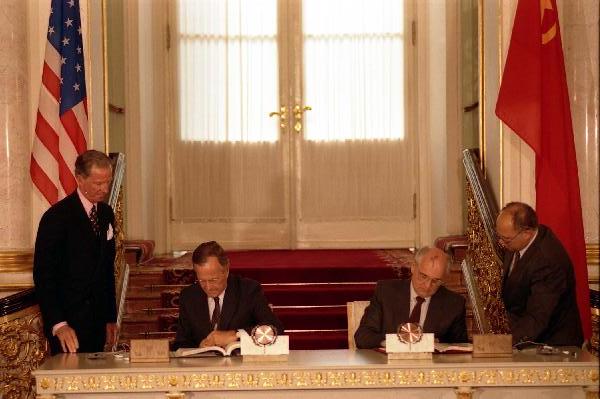Contacts: Daryl Kimball, executive director, (202) 463-8270 x107
The Strategic Arms Reduction Treaty (START) I was signed July 31, 1991, by the United States and the Soviet Union. This was the first treaty that required U.S. and Soviet/Russian reductions of strategic nuclear weapons. It was indispensable in creating a framework that ensured predictability and stability for deep reductions.
In December 1991, the Soviet Union dissolved, leaving four independent states in possession of strategic nuclear weapons: Russia, Belarus, Ukraine, and Kazakhstan. This caused a delay in the entry into force of the treaty. On May 23, 1992, the United States and the four nuclear-capable successor states to the Soviet Union signed the Lisbon Protocol, which made all five nations party to the START I agreement.
START I entered into force Dec. 5, 1994, when the five treaty parties exchanged instruments of ratification in Budapest.
Reductions of nuclear weapons were completed by the deadline of December 5, 2001, seven years after entry into force, and maintained for another eight years. States were verified by on-site inspections and shared missile telemetry. Both the United States and the Russian Federation continued reduction efforts even after reaching the START limits.
START I expired on Dec. 5, 2009. The United States and Russia signed START II in January 1993, but the treaty never entered into force. The 2002 Strategic Offensive Reduction Treaty (SORT, or the Moscow Treaty) entered into force in 2003, followed by the 2010 New Strategic Arms Reduction Treaty (New START) in 2011.
Basic Terms
- 1,600 deployed intercontinental ballistic missiles (ICBMs), submarine-launched ballistic missiles (SLBMs), and heavy (long-range) bombers for each side, including 154 deployed heavy ICBMs (only the Soviet Union possessed the latter type of missile, the SS-18 Satan)
- 6,000 "accountable" warheads on ICBMs, SLBMs, and heavy bombers, of which no more than 4,900 may be on ICBMs and SLBMs, 1,540 on heavy ICBMs, and 1,100 on mobile ICBMs (the latter limitation essentially applied only to the Soviet Union with missiles such as the RS-12M Topol as the United States chose not to deploy such missiles after the treaty’s signing)
- Limited ballistic missile throw-weight (lifting power) to 3,600 metric tons on each side
Counting Rules
- Each reentry vehicle of an ICBM or an SLBM counts as a single warhead.
- Heavy bombers equipped only with bombs or short-range attack missiles (SRAMs) are counted as carrying one warhead each.
- U.S. heavy bombers may carry no more than 20 long-range air-launched cruise missiles (ALCMs) each. The first 150 of these bombers count as carrying only 10 ALCMs each.
- Soviet heavy bombers may carry no more than 16 ALCMs each. The first 180 of these bombers count as carrying only eight ALCMs each.
- No more than 1,250 warheads may be "downloaded" (removed from) and not counted on existing multiple-warhead ballistic missiles.
Inspections and Verification Protocols
- The treaty allows for the use of National Technical Means (NTMs) of verification and prohibits any interference with one another’s NTMs.
- Accompanying the treaty is a Memorandum of Understanding (MOU), which contains data on the numbers and locations of all (deployed and non-deployed) strategic delivery vehicles, plus the locations and diagrams of all facilities associated with strategic delivery vehicles, such as bases and storage and production facilities. The two parties must exchange the entire set of data contained in the memorandum every six months. Each party must notify the other if there is any change in that data shortly after that change occurs.
- The treaty allows for on-site inspections, both short-notice and planned, and continuous monitoring activities in order to verify the data contained in the memorandum. During the first seven years of START, the United States conducted 335 inspections, and Russia conducted 243.
- The treaty permits perimeter and portal monitoring of plants for mobile ICBMs. The United States did not deploy such missiles, so these measures applied only to Russia. (The 1987 Intermediate-Range Nuclear Forces Treaty had already permitted U.S. monitoring of these missiles.)
- The treaty banned any encryption or jamming of telemetry transmitted from ballistic missiles during test launches.
Other Provisions
- START I ran for 15 years with an option to extend for successive five-year periods unless superseded by another agreement. Based on commitments made at the March 1997 Helsinki Summit, the sides agreed in principle to negotiate an agreement making the START treaties unlimited in duration.
- Separate "politically binding" agreements limit the number of deployed nuclear sea-launched cruise missiles with ranges above 600 kilometers to 880 for each side and the number of Soviet Tu-22M Backfire (Tupolev) medium bombers to 500, including no more than 200 naval Tu-22M bombers.

